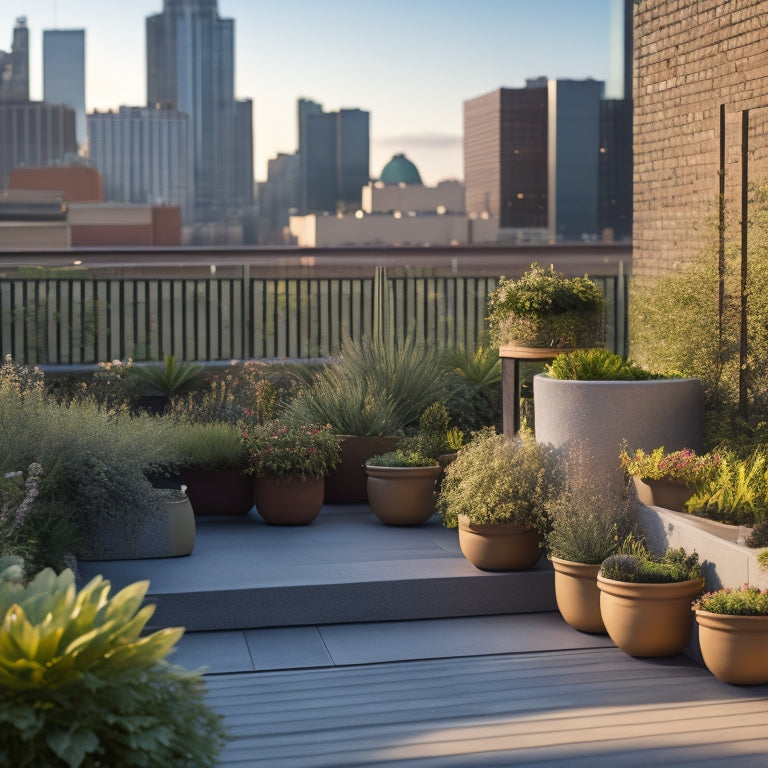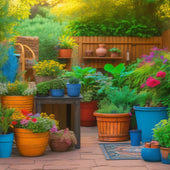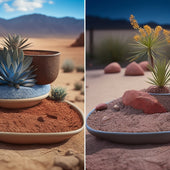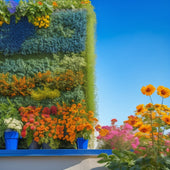
What's the Best Rooftop Vegetable Garden Layout?
Share
As you design your rooftop vegetable garden, prioritize strategic planning to maximize space in small areas. Utilize vertical elements, compact varieties, and space-saving techniques to curate a thriving layout. Consider tiered garden beds, companion planting, and crop rotation to enhance growth and reduce pests. Select lightweight, durable containers with proper drainage and group similar plants together. Don't forget to incorporate visually appealing elements, like varied container types, to create a stunning display. With these fundamental elements in place, you'll be well on your way to crafting a rooftop oasis that yields a bounty of fresh produce - and there's even more to explore to take your garden to the next level.
Key Takeaways
• Maximize space with strategic planning, utilizing vertical elements, compact varieties, and space-saving techniques.
• Incorporate tiered garden beds, curated for optimal growth, to enhance space efficiency and promote healthy plant development.
• Select the right vegetables, considering wind and sun tolerance, seasonal selection, and microclimate awareness, to ensure a thriving rooftop garden.
• Implement efficient irrigation systems, such as drip irrigation, and well-draining soil mixes to prevent waterlogging and nutrient deficiencies.
• Create a visually appealing layout by mixing and matching container types, incorporating pathway design, and using modular vertical growing systems.
Maximizing Space in Small Areas
To create a thriving rooftop vegetable garden in a small area, you'll need to strategically plan every inch of space, utilizing vertical elements, compact varieties, and space-saving techniques to maximize your harvest.
Imagine a tiered garden bed, where each level is carefully curated to optimize growth. You'll want to incorporate companion planting, pairing vegetables that complement each other's growth habits, like tomatoes with basil or marigolds with carrots. This approach not only saves space but also promotes healthy growth and reduces pests.
Crop rotation is another essential technique to master. Divide your rooftop garden into sections, and rotate your crops seasonally to avoid depleting the soil of specific nutrients. For example, follow a nitrogen-fixing legume like beans with a heavy-feeder like tomatoes. This will guarantee your soil remains fertile and your harvest remains bountiful.
Container Gardening for Rooftops
By selecting containers that are specifically designed for rooftop gardens, you can create a thriving oasis in even the most limited of spaces, with built-in features like drainage systems and wind-resistant materials ensuring your plants receive the right amount of water and protection. When choosing containers, consider the type of plants you want to grow and the amount of space you have available.
| Container Type | Plant Selection |
|---|---|
| Deep Planters (12-18 inches) | Tomatoes, Peppers, Cucumbers |
| Shallow Trays (6-12 inches) | Leafy Greens, Herbs, Carrots |
| Hanging Baskets (12-24 inches) | Trailing Veggies, Flowers, Greenery |
For a rooftop garden, it is crucial to select containers that are lightweight, durable, and can withstand harsh weather conditions. You can also mix and match different container types to create a visually appealing layout. Remember to group plants with similar growing requirements together, and don't overcrowd your containers. With the right container selection and plant placement, you'll be enjoying a bountiful harvest from your rooftop garden in no time.
Vertical Growing Systems Work
Maximize your rooftop garden's potential by installing a vertical growing system, which can increase your yield while minimizing space. This provides a living wall of lush greenery that adds visual appeal to your outdoor oasis. With vertical hydroponic systems, you can grow a variety of plants, from leafy greens to vining vegetables, in a compact and efficient manner.
Here are three benefits of incorporating vertical growing systems into your rooftop garden design:
-
Enhanced Yield: By growing plants upwards, you can considerably increase your yield per square foot, making the most of your rooftop space.
-
Improved Aesthetics: Vertical growing systems create a stunning visual display, adding texture, color, and depth to your outdoor space.
-
Modular Flexibility: Many vertical growing systems offer modular gardening solutions, allowing you to easily add or remove sections as needed, making it easy to adapt to changing growing conditions.
Rooftop Garden Pathway Design
As you plan your rooftop garden pathway design, you're faced with a vital decision: choosing the right material to create a visually appealing and functional path.
You'll need to evaluate options that can withstand the elements, provide traction, and complement your garden's overall aesthetic.
Pathway Material Options
You'll have a wide range of pathway material options to choose from for your rooftop garden, each with its unique aesthetic and functional benefits.
When selecting a pathway material, reflect on the overall look and feel you want to achieve in your garden, as well as the practical considerations of drainage and maintenance.
Here are three popular pathway material options to reflect on:
-
Gravel or Decomposed Granite: These materials allow for excellent drainage and can be easily raked to create a visually appealing pattern. Plus, they're budget-friendly and can be found in a variety of colors to match your garden's aesthetic.
-
Wooden Planks or Tiles: Wooden pathways can add a warm, natural touch to your rooftop garden. Look for durable, rot-resistant woods like cedar or recycled plastic wood alternatives.
-
Porcelain or Ceramic Tiles: These materials offer a sleek, modern look and are extremely durable. They're also slip-resistant, making them a great choice for rooftop gardens with heavy foot traffic.
When choosing a pathway material, remember to reflect on factors like drainage solutions and pathway aesthetics to create a functional and beautiful rooftop garden.
Accessible Pathway Routes
With your pathway material selected, it's time to focus on designing a functional and visually appealing route that allows easy navigation throughout your rooftop garden, guaranteeing every corner is accessible and enjoyable.
You want to create a clear path that guides visitors through your garden, highlighting its best features while minimizing obstacles.
Consider a serpentine or meandering pathway to create visual interest and encourage exploration. Wide pathways (at least 3-4 feet) will provide ample space for you and others to move comfortably, while also allowing for easy maintenance and harvesting.
To guarantee garden accessibility, incorporate gentle slopes and ramps to connect different levels, and avoid steep stairs or abrupt changes in elevation.
As you design your pathway, think about regular maintenance tasks, such as watering, pruning, and weeding. Leave enough space between plant beds for easy access and consider incorporating built-in irrigation systems to simplify upkeep.
Soil and Irrigation Considerations
How will you guarantee the soil in your rooftop vegetable garden drains properly, given the added weight and wind exposure, to prevent waterlogged roots and nutrient deficiencies? The key lies in selecting the right soil types and irrigation methods.
When it comes to soil, you'll want to opt for a well-draining mix specifically designed for rooftop gardens. This will assure that excess water doesn't accumulate, causing root rot and other issues.
Here are three essential considerations for soil and irrigation:
-
Lightweight soil: Choose a mix that's engineered to be lighter in weight, reducing the overall load on your rooftop.
-
Drainage layers: Incorporate layers of aggregate, such as perlite or vermiculite, to facilitate water flow and prevent waterlogging.
-
Drip irrigation: Implement a drip irrigation system to deliver water directly to the roots, reducing evaporation and runoff.
Choosing the Right Vegetables
As you've confirmed your rooftop vegetable garden's soil drains properly, it's time to populate it with vegetables that thrive in windy, sunny conditions, such as leafy greens and vining varieties.
Think kale, spinach, and arugula for a lush, vibrant display. Tomatoes, peas, and cucumbers will also thrive, using trellises or cages to maximize space.
Consider companion planting to optimize growth and reduce pests. For example, pair marigolds with tomatoes to deter nematodes, or plant basil near peppers to improve flavor.
When selecting seasonal vegetables, think about the rooftop's microclimate. If your roof receives full sun, choose heat-tolerant varieties like okra, eggplant, or southern peas.
For partial shade, opt for lettuce, radishes, or carrots. Be mindful of your region's frost dates and choose varieties with similar maturity days to confirm a continuous harvest.
Frequently Asked Questions
Can Rooftop Gardens Be Designed for Windy or High-Altitude Areas?
You can design rooftop gardens for windy or high-altitude areas by choosing wind-resistant plants, using trellises for support, and incorporating high-altitude gardening techniques, like raised beds and cold frames, to create a thriving oasis despite harsh conditions.
How Do I Protect My Rooftop Garden From Animal Pests?
You'll want to install garden netting with 1/4-inch mesh to prevent sneaky pests from snacking on your harvest; for added protection, set up a motion-activated sprinkler to deter critters and a physical barrier around vulnerable plants.
Can I Use a Rooftop Garden for Outdoor Entertainment?
You're likely aware that 80% of urban dwellers crave outdoor spaces. Now, imagine transforming your rooftop garden into an entertainment hub by incorporating stylish outdoor seating areas and ambient garden lighting, perfect for hosting friends and family under the stars.
Are Rooftop Gardens More Prone to Disease and Pests?
When you cultivate a rooftop garden, you'll need to be vigilant about disease management and pest prevention, as the confined space can foster ideal breeding grounds for unwanted visitors, but with strategic planning, you can outsmart them.
Do Rooftop Gardens Require Special Insurance Coverage?
As you plan your rooftop garden, you'll want to secure special insurance coverage, considering liability coverage and insurance requirements to protect yourself and others from potential risks, ensuring your green oasis remains a safe haven.
Related Posts
-

3 Best DIY Planter Ideas for Backyard Decor
You can elevate your backyard's style and functionality by choosing the right DIY planter ideas. Start with a mix of ...
-

3 Best DIY Planter Ideas for Backyard Decor
You can elevate your backyard's style and functionality by choosing the right DIY planter ideas. Start with a mix of ...
-

3 Best DIY Planter Ideas for Backyard Decor
You can elevate your backyard's style and functionality by choosing the right DIY planter ideas. Start with a mix of ...
-

3 Best DIY Planter Ideas for Backyard Decor
You can elevate your backyard's style and functionality by choosing the right DIY planter ideas. Start with a mix of ...
-

3 Best DIY Planter Ideas for Backyard Decor
You can elevate your backyard's style and functionality by choosing the right DIY planter ideas. Start with a mix of ...
-

3 Best DIY Planter Ideas for Backyard Decor
You can elevate your backyard's style and functionality by choosing the right DIY planter ideas. Start with a mix of ...
-

3 Best DIY Planter Ideas for Backyard Decor
You can elevate your backyard's style and functionality by choosing the right DIY planter ideas. Start with a mix of ...
-

3 Best DIY Planter Ideas for Backyard Decor
You can elevate your backyard's style and functionality by choosing the right DIY planter ideas. Start with a mix of ...
-

3 Best DIY Planter Ideas for Backyard Decor
You can elevate your backyard's style and functionality by choosing the right DIY planter ideas. Start with a mix of ...
-

3 Best DIY Planter Ideas for Backyard Decor
You can elevate your backyard's style and functionality by choosing the right DIY planter ideas. Start with a mix of ...
-

3 Best DIY Planter Ideas for Backyard Decor
You can elevate your backyard's style and functionality by choosing the right DIY planter ideas. Start with a mix of ...
-

3 Best DIY Planter Ideas for Backyard Decor
You can elevate your backyard's style and functionality by choosing the right DIY planter ideas. Start with a mix of ...
-

3 Best DIY Planter Ideas for Backyard Decor
You can elevate your backyard's style and functionality by choosing the right DIY planter ideas. Start with a mix of ...
-

3 Best DIY Planter Ideas for Backyard Decor
You can elevate your backyard's style and functionality by choosing the right DIY planter ideas. Start with a mix of ...
-

Preventing Soil Settlement in DIY Planters
To prevent soil settlement in your DIY planters, you'll want to focus on selecting a well-balanced soil mix with good...
-

Preventing Soil Settlement in DIY Planters
To prevent soil settlement in your DIY planters, you'll want to focus on selecting a well-balanced soil mix with good...
-

Preventing Soil Settlement in DIY Planters
To prevent soil settlement in your DIY planters, you'll want to focus on selecting a well-balanced soil mix with good...
-

Preventing Soil Settlement in DIY Planters
To prevent soil settlement in your DIY planters, you'll want to focus on selecting a well-balanced soil mix with good...
-

Preventing Soil Settlement in DIY Planters
To prevent soil settlement in your DIY planters, you'll want to focus on selecting a well-balanced soil mix with good...
-

Preventing Soil Settlement in DIY Planters
To prevent soil settlement in your DIY planters, you'll want to focus on selecting a well-balanced soil mix with good...
-

Preventing Soil Settlement in DIY Planters
To prevent soil settlement in your DIY planters, you'll want to focus on selecting a well-balanced soil mix with good...
-

Preventing Soil Settlement in DIY Planters
To prevent soil settlement in your DIY planters, you'll want to focus on selecting a well-balanced soil mix with good...
-

Preventing Soil Settlement in DIY Planters
To prevent soil settlement in your DIY planters, you'll want to focus on selecting a well-balanced soil mix with good...
-

Preventing Soil Settlement in DIY Planters
To prevent soil settlement in your DIY planters, you'll want to focus on selecting a well-balanced soil mix with good...
-

Preventing Soil Settlement in DIY Planters
To prevent soil settlement in your DIY planters, you'll want to focus on selecting a well-balanced soil mix with good...
-

Preventing Soil Settlement in DIY Planters
To prevent soil settlement in your DIY planters, you'll want to focus on selecting a well-balanced soil mix with good...
-

Preventing Soil Settlement in DIY Planters
To prevent soil settlement in your DIY planters, you'll want to focus on selecting a well-balanced soil mix with good...
-

Preventing Soil Settlement in DIY Planters
To prevent soil settlement in your DIY planters, you'll want to focus on selecting a well-balanced soil mix with good...
-

Preventing Soil Settlement in DIY Planters
To prevent soil settlement in your DIY planters, you'll want to focus on selecting a well-balanced soil mix with good...
-

Preventing Soil Settlement in DIY Planters
To prevent soil settlement in your DIY planters, you'll want to focus on selecting a well-balanced soil mix with good...
-

Preventing Soil Settlement in DIY Planters
To prevent soil settlement in your DIY planters, you'll want to focus on selecting a well-balanced soil mix with good...
-

Preventing Soil Settlement in DIY Planters
To prevent soil settlement in your DIY planters, you'll want to focus on selecting a well-balanced soil mix with good...
-

Preventing Soil Settlement in DIY Planters
To prevent soil settlement in your DIY planters, you'll want to focus on selecting a well-balanced soil mix with good...
-

Preventing Soil Settlement in DIY Planters
To prevent soil settlement in your DIY planters, you'll want to focus on selecting a well-balanced soil mix with good...
-

Preventing Soil Settlement in DIY Planters
To prevent soil settlement in your DIY planters, you'll want to focus on selecting a well-balanced soil mix with good...
-

Preventing Soil Settlement in DIY Planters
To prevent soil settlement in your DIY planters, you'll want to focus on selecting a well-balanced soil mix with good...
-

Preventing Soil Settlement in DIY Planters
To prevent soil settlement in your DIY planters, you'll want to focus on selecting a well-balanced soil mix with good...
-

Preventing Soil Settlement in DIY Planters
To prevent soil settlement in your DIY planters, you'll want to focus on selecting a well-balanced soil mix with good...
-

5 Tips for Thriving Vertical Vegetable Gardens
To thrive in vertical vegetable gardening, you'll want to choose a planter that meets the unique needs of your veggie...
-

5 Tips for Thriving Vertical Vegetable Gardens
To thrive in vertical vegetable gardening, you'll want to choose a planter that meets the unique needs of your veggie...
-

5 Tips for Thriving Vertical Vegetable Gardens
To thrive in vertical vegetable gardening, you'll want to choose a planter that meets the unique needs of your veggie...
-

5 Tips for Thriving Vertical Vegetable Gardens
To thrive in vertical vegetable gardening, you'll want to choose a planter that meets the unique needs of your veggie...
-

5 Tips for Thriving Vertical Vegetable Gardens
To thrive in vertical vegetable gardening, you'll want to choose a planter that meets the unique needs of your veggie...
-

5 Tips for Thriving Vertical Vegetable Gardens
To thrive in vertical vegetable gardening, you'll want to choose a planter that meets the unique needs of your veggie...
-

5 Tips for Thriving Vertical Vegetable Gardens
To thrive in vertical vegetable gardening, you'll want to choose a planter that meets the unique needs of your veggie...
-

5 Tips for Thriving Vertical Vegetable Gardens
To thrive in vertical vegetable gardening, you'll want to choose a planter that meets the unique needs of your veggie...
-

5 Tips for Thriving Vertical Vegetable Gardens
To thrive in vertical vegetable gardening, you'll want to choose a planter that meets the unique needs of your veggie...
-

5 Tips for Thriving Vertical Vegetable Gardens
To thrive in vertical vegetable gardening, you'll want to choose a planter that meets the unique needs of your veggie...
-

5 Tips for Thriving Vertical Vegetable Gardens
To thrive in vertical vegetable gardening, you'll want to choose a planter that meets the unique needs of your veggie...
-

5 Tips for Thriving Vertical Vegetable Gardens
To thrive in vertical vegetable gardening, you'll want to choose a planter that meets the unique needs of your veggie...
-

5 Tips for Thriving Vertical Vegetable Gardens
To thrive in vertical vegetable gardening, you'll want to choose a planter that meets the unique needs of your veggie...
-

5 Tips for Thriving Vertical Vegetable Gardens
To thrive in vertical vegetable gardening, you'll want to choose a planter that meets the unique needs of your veggie...
-

5 Tips for Thriving Vertical Vegetable Gardens
To thrive in vertical vegetable gardening, you'll want to choose a planter that meets the unique needs of your veggie...
-

5 Tips for Thriving Vertical Vegetable Gardens
To thrive in vertical vegetable gardening, you'll want to choose a planter that meets the unique needs of your veggie...
-

5 Tips for Thriving Vertical Vegetable Gardens
To thrive in vertical vegetable gardening, you'll want to choose a planter that meets the unique needs of your veggie...


